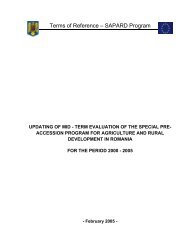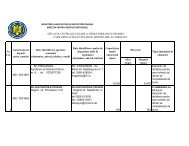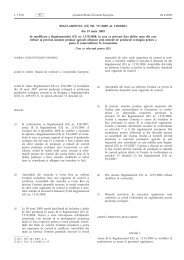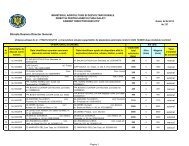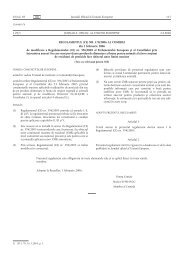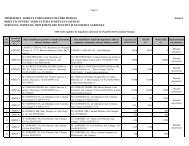Updating of Mid-Term Evaluation of SAPARD in Romania for the period 2000-2005In making a reconnaissance of the system of indicators available and their possible integration,account has been taken of certain criteria, such as:• capacity to reflect adequately the state of the outputs;• clarity of definition;• adherence to the questions posed by the CEQ.A first distinction is made between the programme indicators and the context indicators. Theformer aim representing the direct effects of the programme on the portion of territory orpopulation concerned by it, while the latter refers to the entire territory and/or to the populationas a whole, enabling the results of the actions to be contextualised.The output indicators are:‣ financial indicators whereby the level of mobilisation of the financial resources ismeasured;‣ physical indicators with which the work progress is measured.Financial Indicators.These are constructed from the ratios between commitments and allocations, distinguishing:• effective capacity of progress, given by the ratio between commitments and allocations;• effective capacity of utilisation, given by the ratio between payments and commitments.Considering also the measures identified and those in process of selection, it has beenpossible to elaborate two other typologies of indicators, that is:• potential capacity to make progress;• potential commitment capacity.Physical IndicatorsTheir definition in integration of those available is linked to the quantification of the physicalobjectives of implementation, so that the distinction is drawn between physical objectivesachieved, achievable and to be achieved.The basic data collected are represented by• physical objectives achieved, referred to the allocation attributed to projects concluded;• physical objectives achievable, referred to the allocation attributed to projects beingimplemented and identified;• physical objectives to be achieved, referred to the allocations attributed to projects inthe selection phase and not yet identified.The use of indicators of result enables the direct results obtained by implementing theactions to be measured.In the course of the mid-term evaluation the indicators of result have maked it possible on theone hand to follow the physical and financial progression of the actions, and on the other handto formulate the first projections as to the achieving of permanent effects. The typology of theindicators of result selected depends on a number of characteristics both of the beneficiaries ofthe measures and of users of the outputs, such as:12
Updating of Mid-Term Evaluation of SAPARD in Romania for the period 2000-2005• characteristics of the beneficiaries (location, average dimensions, etc.);• reaction of the potential beneficiaries (effective beneficiary enterprises of the totalpotential beneficiary enterprises);• capacity of qualitative improvement of supply;• decisions consequent upon the measures (increase in jobs).The Impact Indicators measure the specific impact, consequent upon the outputs and theresults obtained, and the global impact, consequent upon the specific objectives achieved. Themid-term evaluations update focus on the specific impacts; as it is the task of the ex-postevaluation to pay more attention to the global impact.The capacity of the monitoring service to provide the information necessary to support it andconsequently to complete the finalization of the system to collect the primary data, is assed.1.3.3 Sources of dataA first source of information is represented by the monitoring results, by earlier investigationsand studies, and by the information contained in the programming documents. In particular, theaforesaid source has been suitable for providing data of procedural and financial type, and theresults obtained during programme implementation. The secondary data are integrated withstatistical information provided by Qs surveys combined with basic information linked to thelocal context and in particular that of the sector.The direct collection by the Evaluator of the primary data has been a central element of theevaluation system as it makes it possible to obtain original information targeted on theperformance of the service whose qualitative level is closely connected with the functionality ofthe collection. A fair part of the primary data comes from the direct beneficiaries and therepresentativeness of the results guarantees its capacity to provide the programme results andimpacts.Below the data surveyed are classified in homogeneous categories according to the nature ofthe datum, survey source and connection with the individual indicators in the various chaptersof the CEQ, so as to clarify the Evaluator’s approach to the construction of the data surveysystem and to the integration of the sources of primary and secondary data.Nature of DatumSurvey sourcesReference toChapters of theCEQData of an economic, financial,structural and productive nature (levelof use of means of production such aswater, fertilisers, pesticides) relating tothe farms and forestry units, and toinformation regarding the “labour”factor within them.Analytical data relating to thequantitative and qualitative availabilityof ground waters and surface waters.Data relating to the impacts on thenatural systems bordering on thecultivated areas and concerned by themeasures, including data relating tostructural and qualitative aspects of• Monitoring Committee;• Direct inquiries on farms (interviews,questionnaires, case studies);• FADN;• National and regional accountingstatistics• Planning documents.• Monitoring Committee;• Direct inquiries on farms (interviews,questionnaires, case studies);• Sample analytical surveys.• Monitoring Committee;• Targeted investigations conductedoutside of farms (sampling, testareas);• National and regional statistics;Chapter AChapter CChapter AChapter AChapter C13




